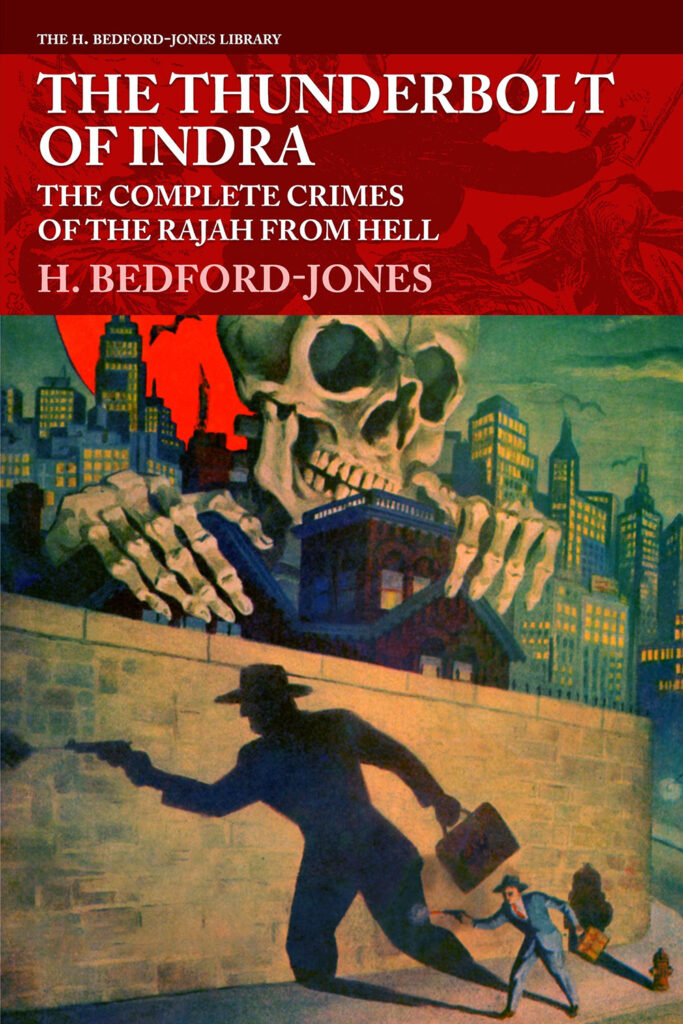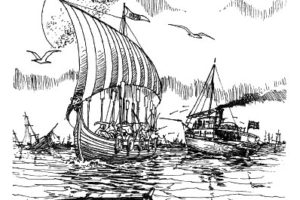From the prolific H. Bedford-Jones (1887-1949) we have his “The Rajah from Hell” series, which ran in Blue Book magazine. Depending on how you look at it, it’s either a four-part series or a four-part novel, which ran in issues December 1946 through March 1947. It appeared under his Gordon Keyne byline and is a crime thriller.
 The series is available from two publishers. Steeger Books has reprinted it in their “H. Bedford-Jones Library” series as The Thunderbolt of Indra: The Complete Crimes of the Rajah From Hell. I don’t know the source of the cover artwork, as none of the stories were cover featured. The covers from Blue Book is shown on the back cover.
The series is available from two publishers. Steeger Books has reprinted it in their “H. Bedford-Jones Library” series as The Thunderbolt of Indra: The Complete Crimes of the Rajah From Hell. I don’t know the source of the cover artwork, as none of the stories were cover featured. The covers from Blue Book is shown on the back cover.
Black Dog Books also reprinted the series as The Rajah From Hell under a new cover, I assume from publisher Tom Roberts. I have the Steeger edition, which includes the original interior artwork from the pulps. I assume the BDB edition did as well.
The basic story is that four men have been marked for death by the vengeful Rajah From Hell. In each of the four stories, one of the men will be dealt with.
Things start when we meet the hero of our story, Hugh Clements, M.D., returning to the U.S. after seven years in India, now that WWII is over. He had been running a hospital in the far north part of India, near Tibet. Now he hopes to find a new job and also reconnect with some old friends, in particular Sir James Trent and his daughter, Virginia. Trent had been a judge in the same area of India, and he hopes Virginia will become more than just a friend.
At the customs dock in Los Angeles, he encounters a strange pair. One is Howard Chaffee, who seems to be afflicted with some aliament, and the other is a regal Hindu, no name given. Clements finds they are staying at the same hotel and Clements feels like he has met the Hindu, who by his expression seems to recognize Clements as well, but does not remark on it.
While at the hotel, he is contacted by the Hindu and asked to help Chaffee, who has been overcome by an attack due to his ailment. The hotel doctor can’t help. Clements soon discovers that Chaffee shows the sign of torture that he has seen in Tibet, and knows how to at least relieve him of his attack, though cannot heal him. The Hindu, who never gives his name, reminds Clements of an incident from three years prior, where he helped a man grieviously hurt, who he took to his hospital to recover, but he disappeared. The Hindu says the man was a friend, now dead, but he was grateful for his help. Clements wonder if the Hindu is lying, and the man was the Hindu himself.
Finally, visiting Sir Trent and Virginia, Clements finds Sir Trent dead! He had been stabbed in the head, but whatever did it left a strange wound. He soon learns that Sir Trent had been threatened, but had ignored it.
Clements meets an associate, a Colonel Angus MacGruder, who had also served in India. And finds that Sir Trent and three others had been threatened by a dacoit they had sentenced by the name of Ram Lal. He was the head of a bandit group and was captured. An American teak-importer named Gerard Chaffee, brother of Howard, had identified him as Ram Lal. MacGruder had captured him. And Fitzjames Balfour, now also living in California, prosecuted him. The British believed Ram Lal was also an agent of the communists and wished to get rid of him, and he was sentenced to life in prison, but somehow escaped and was believed dead. Later they learned he was the nephew and heir to the Rajah of Sirvath. All are now marked for death.
Going to visit Virginia, Clements encounters the agents of the Rajah, who try to kill him with a “varja,” the weapon that caused the strange wound that killed Sir Trent! Clements is able to kill the main one, but is captured by the rest. He soon awakes in the home of the Rajah, and is told his story. The Rajah is not Ram Lal, but was part of his gang, but was no criminal. Chaffee falsely claimed he was Ram Lal, and even though he claimed his innocence and revealed who he was, was tried and convicted, but escaped. Now, being the rightful Rajah of Sirvath, he will now wreak his vengence on those who wronged him. Though due to Clements’ past kindness, he will not harm Clements. But he can not promise his agents won’t. Clements is drugged and finds himself at a hospital, with no knowledge of where he was or the Rajah’s real name or identity.
So, one man was killed along with an innocent nurse, and three more are in danger. But as the actual killer, an agent of the Rajah, is dead, the police think the matter done. Few believe Clements’ claims of danger from the “Rajah From Hell.” He doesn’t know his real name, as he goes under aliases. The authorities don’t believe him, but he will be able to find others who can help, including an immigration officer who comes in late in the third story. Will the Rajah succeed in his quest? Or will Clements and his allies stop him. If he does succeed with his mission of vengeance, will he be caught or killed?
Another interesting short series from Bedford-Jones. I certainly could see this turned into a TV mini series or movie. I found the quality of the writing a little different from the works I’ve previously read by HBJ, but many I’ve read are from the 1920s and ’30s, and this was written much later in his career. This is a great crime thriller, with twists and dangers, with the villain almost always one step ahead of the hero. But the hero is dogged and right there to try to thwart him. Well worth the read.



